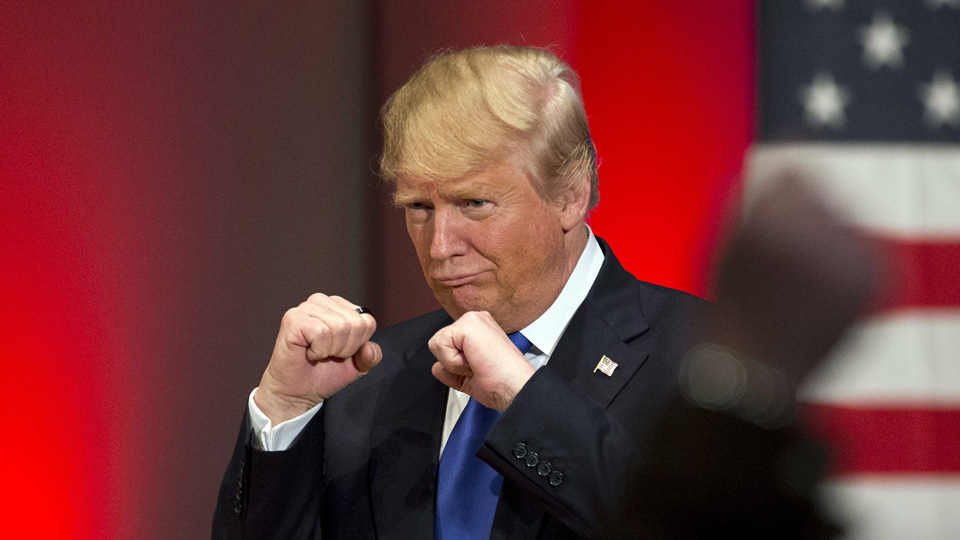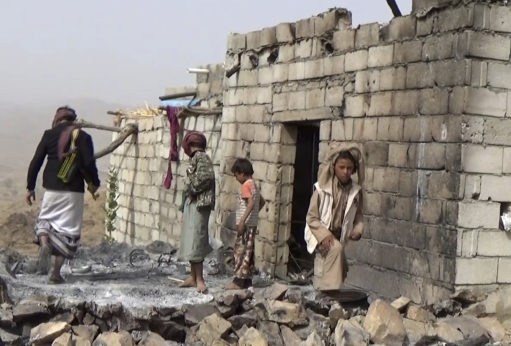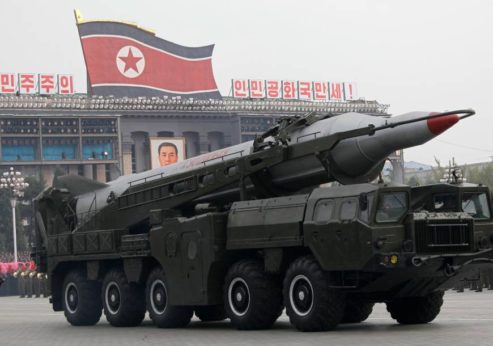
“Chaos,” “dismay,” “radically inept” – these are just a few of the headlines analyzing President Donald Trump’s foreign policy, and in truth, disorder would seem to be the strategy of the day. Picking up the morning newspaper or turning on the national news sometimes feels akin to opening up a basket filled with spitting cobras and Gabon Vipers.
But the bombast emerging for the White House hasn’t always matched what the Trump administration does in the real world. The threat to dump the “One-China” policy and blockade Beijing’s bases in the South China Sea has been dialed back. The pledge to overturn the Iran nuclear agreement has been shelved. And NATO’s “obsolescence” has morphed into a pledge of support. Is common sense setting in, as a New York Times headline, “Foreign Policy Loses Its Sharp Edge as Trump Adjusts to Office”?
Don’t bet on it.
First, this is an administration that thrives on turmoil – always an easier place to rule from than order. What it says and does one day may be, or may not be, what it says or does another. And because there are a number of foreign policy crises that have stepped up to the plate, we should all find out fairly soon whether the berserkers or the rationalists are running things.
Target: Iran
The most dangerous of these is Iran, which the White House says is “playing with fire” and has been “put on notice” for launching a Khorramshahr medium-range ballistic missile. The missile traveled 630 miles and exploded in what looks like a failed attempt to test a re-entry vehicle. Exactly what “notice” means has yet to be explained, but Trump has already applied sanctions for what it describes as a violation of the 2015 Joint Comprehensive Program of Action – UN Security Council Resolution 2231 – in which Iran agreed to dismantle much of its nuclear energy program.

A 2010 UN resolution did, indeed, state, that Iran “shall not undertake activity related to ballistic missiles.” But that resolution was replaced by UNSCR 2231, which only “calls upon Iran not to test missiles,” wording that “falls short of an outright prohibition on missile testing,” according to former UN weapons inspector Scott Ritter.
The Iranians say their ballistic missile program is defensive, and given the state of their obsolete air force, that is likely true.
The Trump administration also charges that Iran is a “state sponsor of terror,” an accusation that bears little resemblance to reality. Iran is currently fighting the Islamic State and al-Qaida in Syria, Iraq, and through its allies, the Houthi, in Yemen. It has also aided the fight against al-Qaida in Afghanistan. As Ritter points out, “Iran is more ally than foe,” especially compared to Saudi Arabia, “whose citizens constituted the majority of the 9/11 attackers and which is responsible for underwriting and the financial support of Islamic extremists around the world, including Islamic State and al-Qaida.”
In an interview last year, leading White House strategist Steve Bannon predicted, “We’re clearly going into, I think, a major shooting war in the Middle East again.” Since the U.S. has pretty much devastated its former foes in the region – Iraq, Syria, and Libya – he could only be referring to Iran.
The administration’s initial actions vis-à-vis Tehran are, indeed, worrisome. U.S. Secretary of Defense Jim Mattis recently considered boarding an Iranian ship in international waters to search it for weapons destined for the Houthi in Yemen. Such an action would be a clear violation of international law and might have ended in a shootout.
The Houthi practice a variation of Shiism, the dominant Islamic school in Iran. They do get some money and weapons from Tehran, but even U.S. intelligence says that the group is not under Tehran’s command.
The White House also condemned a Houthi attack on a Saudi warship (initially Trump Press Secretary Sean Spicer called it an “American” ship), even though the Saudis and their Persian Gulf allies are bombing the Houthi and the Saudi Navy – along with the U.S. Navy – is blockading the country. According to the UN, more than 16,000 people have died in the three-year war – 10,000 of them civilians.
Apparently the Trump administration is considering sending American soldiers into Yemen, a course of action which would put the U.S troops in the middle of a war involving the Saudis and their allies, the Houthi, Iran, al-Qaeda, the Islamic State, and various south Yemen separatist groups.
Putting U.S. ground forces into Yemen is a “dangerous idea,” according to Jon Finer, chief of staff for former U.S. Secretary of State John Kerry. But a U.S. war with Iran would be as catastrophic for the Middle East as the invasion of Iraq. It would also be unwinnable unless the U.S. resorted to nuclear weapons, and probably not even then.
For all its flaws, Iran’s democracy is still arguably light years ahead of most other U.S. allies in the region, and Iranians would strongly rally behind the government in the event of a conflict.
Pre-emptive strike on North Korea?

The other foreign policy crisis is the recent missile launch by North Korea, although so far the Trump administration has let the right-wing Prime Minister of Japan, Shinzo Abe, carry the ball on the issue.
Meeting with Trump in Florida, Abe called the Feb. 12 launch “absolutely intolerable.” Two days earlier Trump had defined halting North Korean missile launches as a “very, very high priority.”
The tensions with North Korea over its nuclear weapons and missile program are long running, and this particular launch was hardly threatening. The missile was a mid-range weapon and only traveled 310 miles before breaking up. The North Koreans have yet to launch a long-range ICBM, although they continue to threaten that one is in the works.
According to a number of Washington sources, Barak Obama told Trump that North Korea posed the greatest threat to U.S. military forces, though how he reached that conclusion is puzzling. It is estimated North Korea has around one dozen nuclear weapons with the explosive power of the Hiroshima and Nagasaki bombs, about 20 kilotons. The average U.S. warhead packs an explosive force of from 100 to 475 kilotons, with some ranging up to 1.2 megatons. It has more than 4,000 nuclear weapons.
While the North Koreans share the Trump administration’s love of hyperbole, the country has never demonstrated a suicidal streak. A conventional attack by the U.S., South Korea, and possibly Japan would be a logistical nightmare and might touch off a nuclear war, inflicting enormous damage on other countries in the region. Any attack would probably draw in China.
What the North Koreans want is to talk to someone, a tactic that the Obama administration never tried. Nor did it consider trying to look at the world from Pyongyang’s point of view. “North Korea has taken note of what happened in Iraq and Libya after they renounced nuclear weapons,” says Norman Dombey, an expert on nuclear weapons and a professor of theoretical physics at Sussex University. “The U.S. took action against both, and both countries’ leaders were killed amid violence and chaos.”
The North Koreans know they have enemies – the U.S. and South Korea hold annual war games centered on a military intervention in their country – and not many friends. Beijing tolerates Pyongyang largely because it worries about what would happen if the North Korean government fell. Not only would it be swamped with refugees, it would have a U.S. ally on its border.
Obama’s approach to North Korea was to isolate it, using sanctions to paralyze the country. It has not worked, though it has inflicted terrible hardships on the North Korean people. What might work is a plan that goes back to 2000 in the closing months of the Clinton administration.
That plan proposed a non-aggression pact between the U.S., Japan, South Korea, and North Korea and the re-establishment of diplomatic relations. North Korea would have been recognized as a nuclear weapons state, but agree to forgo any further tests and announce all missile launches in advance. In return, the sanctions would be removed and North Korea would receive economic aid. The plan died when the Clinton administration got distracted by the Middle East.
Since then, the U.S. has insisted that North Korea give up its nuclear weapons, but that is not going to happen – see Iraq and Libya. In any case, the demand is the height of hypocrisy. When the U.S. signed the Nuclear Non-Proliferation Treaty, it agreed to Article VI that calls for “negotiations in good faith” to end “the nuclear arms race at an early date and to nuclear disarmament.”
All eight nuclear powers – the U.S., Russia, China, France, Britain, India, Pakistan, and Israel – have not only not discussed eliminating their weapons, all are in the process of modernizing them. The NPT was never meant to enforce nuclear apartheid, but in practice that is what has happened.
A non-aggression pact is essential. Article VI also calls for “general and complete disarmament,” reflecting a fear by smaller nations that countries like the U.S. have such powerful conventional forces that they don’t need nukes to get their way. Many countries – China in particular – were stunned by how quickly and efficiently the U.S. destroyed Iraq’s military.
During the presidential campaign, candidate Donald Trump said he would “have no problem” speaking with North Korean leader Kim Jung Un. That pledge has not been repeated, however, and there is ominous talk in Washington about a “preemptive strike” on North Korea, which would likely set most of north Asia aflame.
A world of wars
There are a number of other dangerous flashpoints out there besides Iran and North Korea.
The Syrian civil war continues to rage and Trump is talking about sending in U.S. ground forces, though exactly who they would fight is not clear. Patrick Cockburn of the Independent once called Syria a three-dimensional chess game with nine players and no rules. Is that a place Americans want to send troops into?
Meanwhile, the commander of U.S. forces in Afghanistan – now America’s longest running war – is asking for more troops.
In Eastern Ukraine, war smolders on, and with NATO pushing closer and closer to the Russian border, there is always the possibility of misjudgment. The same goes for Asia, where Bannon predicted “for certain” the U.S. “is going to go to war in the South China Sea in five to 10 years.”
How much of the White House’s tweets are provocation and grandiose rhetoric is not clear. The President and the people around him are lens lice who constantly romance the spotlight. They have, however, succeeded in alarming a lot of people. As the old saying goes, “Boys throw rocks at frogs in fun. The frogs dodge them in earnest.”
Except in the real world, “fun” can quickly translate into disaster, and some of the frogs are perfectly capable of tossing a few of their own rocks.
This article originally appeared on the author’s blog, Dispatches from the Edge.







Comments